by Nancy Jaffer | Mar 14, 2025
Global Medics, whose product Relax Pro was given to an Olympic eventing horse at the Paris Games, contends in a public statement that the supplement was contaminated with Trazodone at the production level,
Relax Pro was found to be responsible for a positive doping test on the horse Dia van het Lichterveld Z, ridden by Tine Magnus during the 2024 Olympics. Her disqualification led to the loss of the Belgian team’s fourth-place finish. The rider had been told by the team vet to use Relax Pro.
Trazodone is an anti-depressant that is sometimes prescribed as a sleep aid for humans.
“We deeply regret this incident—for Tine Magnus, for the entire Belgian eventing team, and for the equestrian sport as a whole,” the company noted, adding that the situation “is beyond our control.”
“This is not a case of deliberate doping aimed at enhancing performance but rather an unfortunate case of contamination. As soon as thorough research confirmed that a batch of Relax Pro contained traces of Trazodone, Global Medics transparently communicated this objective information on its official website, pending further in-depth investigation.
The affected batches (24D02CA and CA/23J31) were immediately withdrawn from the market. Those who have the supplement with those numbers should contact Global Medics. The company emphasized that in terms of health issues, the supplement contained “a clinically irrelevant dose of Trazodone,” adding, “We can also confirm with certainty that all newly produced products are completely free of this contamination.
“Current findings indicate that the contamination occurred at the production level, resulting from a contaminated magnesium raw material sourced from Spain.” Investigations into the situation are continuing.
“While Tine Magnus is undoubtedly the greatest victim of this situation, Global Medics has also suffered significant reputational and business damage. We emphatically state that Trazodone was never intentionally added to our products, contrary to some insinuations in equestrian media and on social platforms. This contamination occurred entirely outside of our control, at the raw material supplier level,” the company maintained.
It noted, “This incident raises an important question: how can supplement distributors and riders protect themselves from unforeseen contamination of this nature? It is concerning and disappointing that, in such crisis situations, there is not more unity and understanding within the industry to support Tine Magnus and collectively seek solutions for the future.”
When the investigation is complete, the company promised to share the whole story.
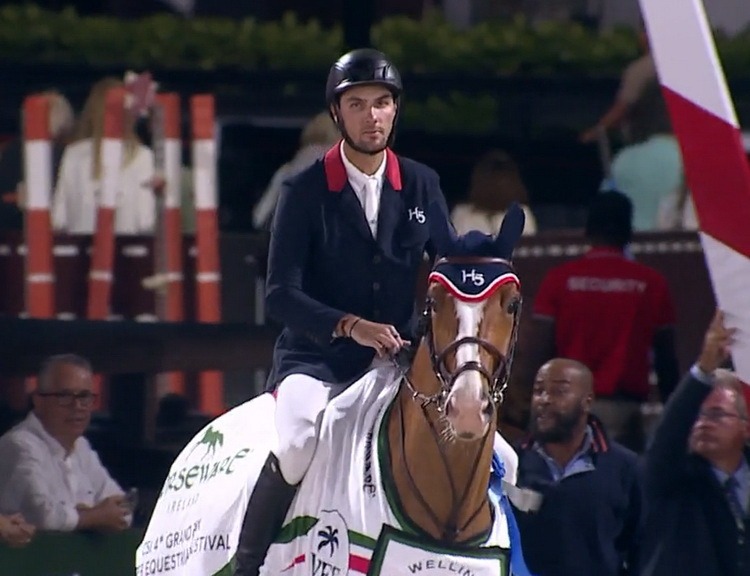
by Nancy Jaffer | Mar 15, 2025
Mexico’s Carlos Hank Guerreiro found himself in the Wellington International winner’s circle Saturday night with an amazing ride in the $215,000 FEI 4-star Horseware Ireland Grand Prix.
Bold and determined as he set off against the clock, he was fifth to go in a 14-horse tiebreaker, brilliantly handling the turns on Oscar Soberon’s twisting jump-off course to bring H5 Porthos Maestro WH Z home in 39.98 seconds.

Mexico’s Carlos Hank Guerreiro and H5 Porthos Maestro WH Z.
Last to go, Egypt’s Nayel Nassar on Esi Ali had what would have been the winning time — 39.92 seconds — but a giant leap to the last fence caused a rail to hit the ground and he wound up ninth as the fastest 4-faulter.
Former eventer Marilyn Little of the U.S. executed a skillful trip with La Contessa, though she didn’t break the 40-second mark, finishing in 40.55 seconds to end up a very respectable second. An Irish rider, Tom Wachman, was third on Do it Easy, clear in 40.61.
“I have a very fast horse in Porthos, and it was a big enough jump-off with some very fast riders behind me,” said Hank, who has been working with the 11-year-old Zangersheide gelding by Picasso Z for four years.
The 24-year-old rider pointed out, “I didn’t want to leave it all out on the line because you still have to leave the jumps up. I wanted to take the risks I knew I could, and it paid off today.”
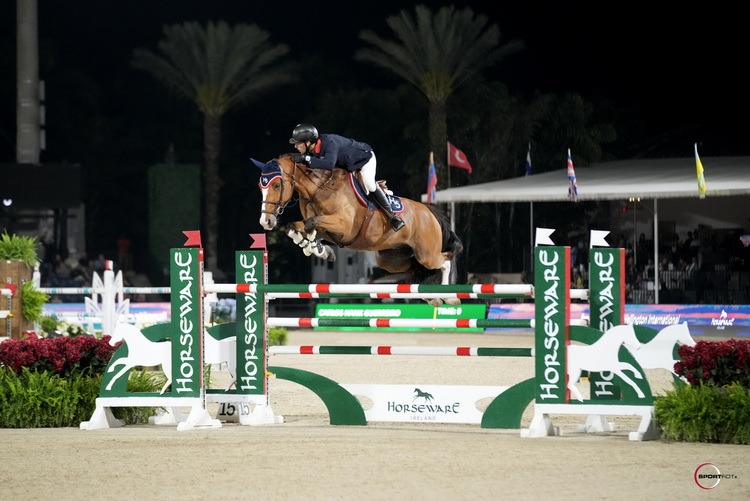
Carlos Hank Guerreiro on the way to victory. (Sportfot photo)
He added, “The atmosphere here has always been unbelievable; I’ve been jumping here for a few years now and these ‘Saturday Night Lights’ are very special. It’s what motivates us during the week. To win one has always been a dream of mine so I’m very grateful.
“It’s a very tough place to win. If you can win here, you can win anywhere.”
The class drew 40 starters. McLain Ward wound up 18th on High Star Hero with one rail in the first round. Beezie Madden was eliminated when she had a fall from Nairobi early on course, but walked out of the ring unaided.
Click here for results

by Nancy Jaffer | Mar 13, 2025
A celebration of Rodney Jenkins’ life June 1 will offer a chance to reminisce about the Red Rider and meet with friends to recall what made him so special. The gathering will be held from 3-5 p.m. at the Upperville, Va., horse show grounds in the 1853 Club on the jumper side.
Rodney, considered the greatest U.S. show jumping rider of all time by many, died last December at age 80. In addition to his achievements in the show ring, Rodney went on to become a successful trainer of thoroughbred racehorses.

Rodney in action with his most famous horse, Idle Dice.
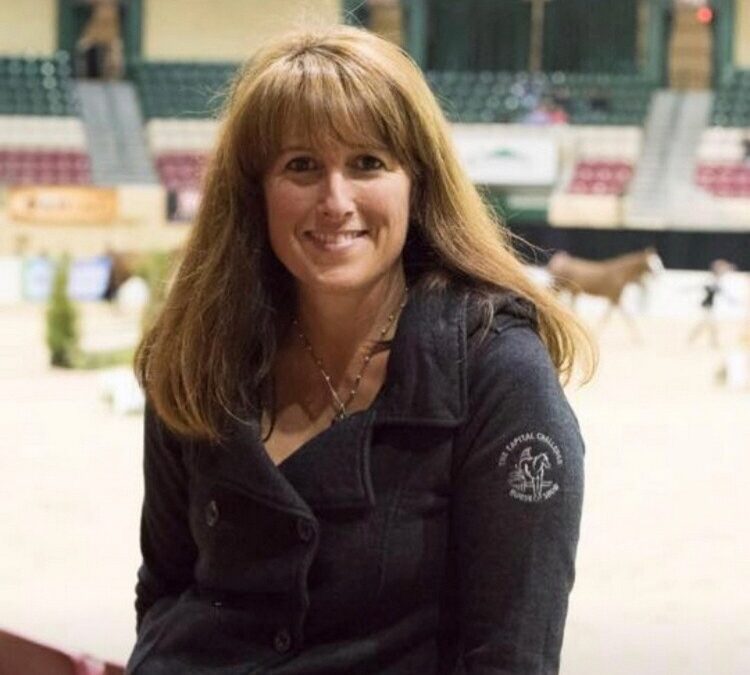
by Nancy Jaffer | Mar 6, 2025
Talented writer, website designer and book publisher Michelle Bloch died Monday March 3 of breast cancer. She was 55.
Michelle had been a pillar of the Capital Challenge Horse Show since 1996, designing the program and prizelist and writing its daily update during the show.

Michelle Bloch at the Capital Challenge Horse Show. (Tricia Booker photo)
“It’s a big loss,” said Oliver Kennedy, the show’s manager and co-founder, said of her passing.
He noted that whenever Michelle was presented with a concept, “she ran with it and made it amazing. Whatever you asked her to do, she figured it out and did it,” he added, saying she always gave “150 percent.”
She was the “keeper of knowledge” for the show with statistics, figures, photos and winners from the past 31 years.
A successful competitor during her time in the junior ranks, Michelle taught riding and kept horses at her Branchville, N.J., farm, but eventually focused on writing and designing.
Tricia Booker, co-founder of the Ink Horse book publishing venture with Michelle, noted her friend loved nature and hiking, but was “as comfortable in a city as in the middle of nowhere.”
Michelle was an intern at the Chronicle of the Horse in 1991 when Tricia was an editor there, and went on to write many freelance articles.
“Throughout my 25-plus years at the Chronicle, Michelle was one of the writers I counted on to always provide accurate and well-written articles,” Tricia remembered.
“When they arrived in my inbox, I’d sigh with relief knowing I could relax and just enjoy the story rather than having to do a rewrite. Michelle always met the tight deadlines of our weekly magazine, and her creativity and beautiful way with words made her work stand out among the rest.”
The two went on to work together at the U.S. Hunter Jumper Association’s In Stride magazine.
“She became much more than a freelancer to me; she was my collaborator,” said Tricia, who admired Michelle’s fashion sense that was part of her flair.
At In Stride, “Although she didn’t have a title on the masthead, she should have had one,” Tricia observed.
“We spent countless hours on the phone discussing article ideas, people to interview, industry trends, horse care topics, the importance of continuing education and so much more. I lost count of the number of American Horse Publications Awards her articles received, but it has to be in the double digits.”
Public relations executive Jennifer Wood, who worked with Michelle at Capital Challenge, noted how helpful her friend was when she launched Equestrian Businesswomen and played a major role in making it successful.
“From the start, she provided her design services and her creative eye to design the logo, build the website, make all the graphics, and bounce around all the ideas for the original 2019 Summit,” Jennifer recalled.
“She continued to support EQBW through the founding of the Equestrian B2B podcast, of which she was guest on the 26th episode about “How to Be Creative and Keep Creativity Consistent” and on Episodes 63 and 51, when she helped recap the 2024 EQBW Networking Brunch and 2023 Saratoga Women In Business Spectacular.
Michelle’s written work can be seen at her website, Writersbloch.com, and on Substack.
In one piece, she elaborated on the painstaking process of putting words together to achieve what she wanted them to mean.
“And then, when it is finally complete,” she stated, “the sun shines and the birds sing and voila, I have written… Past tense.”
Michelle is survived by her parents, Phyllis and Wolf Gstattenbauer; her husband, David Bloch, and their daughter, Abigail. Those wishing to make a donation in Michelle’s memory should contribute to the charity of their choice that most reminds them of her, orThe National Parks Foundation (nationalparks.org)
A celebration of life for Michelle will be held on March 30 from 2-4 p.m. at The Conservatory at the Sussex County Fairgrounds. Online condolences may be offered to the family at www.fergusonfuneralhomesnj.com

by Nancy Jaffer | Feb 24, 2025
The developer of the proposed Isla Carroll development adjacent to the National Polo Center off 120th Avenue South had asked for an delay of approximately 30 days on a vote, when it appeared in January that Wellington’s Planning, Zoning and Adjustment Board was going to turn down its proposed project in the Equestrian Preserve.
But representatives of the Discovery Land Co. were not on the agenda for the PZAB’s February meeting. Tim Stillings, Wellington’s director of Planning, Zoning and Building, reported to the board that the developer was involved with a re-do of the proposal for a Planned Unit Development on the 79.171-acre property. The land is part of the Village’s Equestrian Preserve, where two-acre zoning is the norm.
The plan called for 35 houses on one-third of an acre, and five properties of 1.5 acres where horses could be kept, with room for a paddock, stalls and a sand ring.
An equestrian center would have a 24-stall stable, housed in a refurbished barn on the property, where rescue horses and retired horses would be housed. The ambitious undertaking called for them to be used for every equestrian pursuit from jumping to endurance, vaulting and dressage.
The quirky plan presented to the Equestrian Preserve Committee, which unanimously voted against the project in January, and the PZAB raised concerns about its feasibility. There were many questions that went unanswered or received answers that appeared to be unrealistic.
“We have to be convinced this is an equestrian amenity and that this isn’t just a housing community with an equestrian label on it,” said Michael Drahos, a PZAB member who formerly served on the Village Council.
Such comments prompted the developer to request a halt to the proceedings and ask for extra time to refine the plan. If it is resubmitted, it once again will have to be heard by the Equestrian Preserve Committee before it goes before the PZAB. Both panels are only advisory, however. The decision on any project is made by the Village Council.
Click here to read a previous story on Isla Carroll.
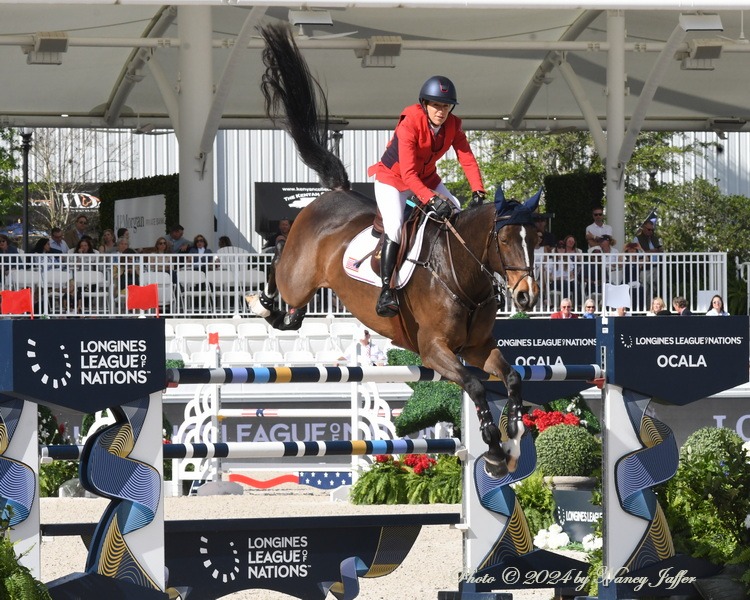
by Nancy Jaffer | Mar 4, 2025
What a remarkable group! The legends who gathered for the annual Show Jumping Hall of Fame dinner in Wellington, Fla., over the weekend have an incredible list of glittering achievements in the sport.
The Hall at the U.S. Hunter Jumper Association Wheeler Museum honors these stars, both human and equine, with more deserving giants of the discipline added every year.
This time it was the turn of Olympic team gold medalist Laura Kraut, who is still going strong at age 57 and competed in the Nations Cup the night before the dinner.

Laura Kraut and Baloutinue. (Photo © 2024 by Nancy Jaffer)
Buddy Brown’s versatile ride, the late Sandsablaze, was also inducted. A champion equitation horse and hunter before becoming an Olympic show jumper, this thoroughbred showed the ability and mettle of his breed–all too often overlooked today as warmbloods dominate the sport.
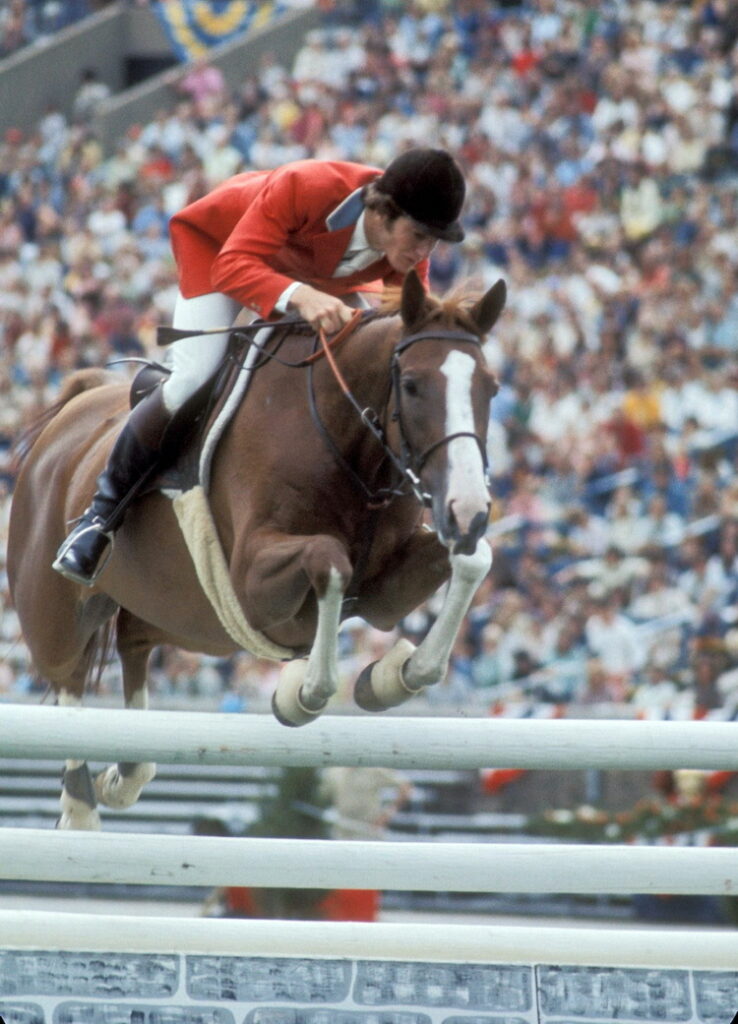
Sandsablaze and Buddy Brown (Hall of Fame photo)
Also honored at the dinner was Mario Deslauriers, a former U.S. team member who now rides for Canada. He received the International Award. Pancho Lopez, a great groom and manager who taught many others to excel in those professions, was a member of the 2023 Show Jumping Hall of Fame class. He wasn’t able to attend last year, so he accepted the honor at the dinner for the class of 2024.

Hall of fame members gather for a photo after last weekend’s installation dinner. (Hall of Fame photo)
Can you identify all the people in the photo? In the back row are Pancho Lopez, Norman Dello Doio, Peter Doubleday, Robert Ridland, Linda Allen, Anne Kursinski, David Distler, Michael Matz, Anthony D’Ambrosio, Dr. Dan Marks.
Seated are Margie Engle, Laura Kraut, Katie Monahan Prudent, Mary Mairs Chapot, Melanie Smith Taylor, Jane Clark, Leslie Burr Howard, Beezie Madden.












